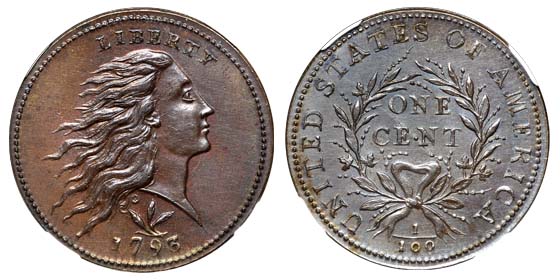
Year | Mint | Variety | Designation | VG-8 | F-12 | VF-20 | EF-40 | AU-50 | U-60 | MS-63 | MS-64 | MS-65 | MS-66 | MS-67 |
|---|---|---|---|---|---|---|---|---|---|---|---|---|---|---|
1800 | P | Plain 4- Stemless Wreath | Red-brown | 200 | 300 | 400 | 500 | 600 | 700 | 800 | 900 | 1000 | 1200 | 1100 |
| Year | Mint | Variety | Designation | VG-8 | F-12 | VF-20 | EF-40 | AU-50 | MS-60 | MS-63 | MS-64 | MS-65 | MS-66 |
|---|---|---|---|---|---|---|---|---|---|---|---|---|---|
| 1793 | (None) Phil | AMERI. | BN | $13,175.00 | $21,575.00 | $34,520.00 | $72,790.00 | $106,825.00 | $450,000.00 | $667,500.00 | $1,100,000.00 | $2,500,000.00 | -- |
| 1793 | (None) Phil | AMERICA | BN | $11,250.00 | $18,250.00 | $28,200.00 | $53,900.00 | $74,500.00 | $216,250.00 | $332,250.00 | $490,000.00 | $873,750.00 | $1,925,000.00 |
| 1793 | (None) Phil | AMERICA | RB | -- | -- | -- | -- | -- | -- | -- | -- | $1,100,000.00 | -- |
| 1793 | (None) Phil | Periods | BN | $11,000.00 | $19,250.00 | $29,950.00 | $63,900.00 | $102,000.00 | $192,500.00 | $324,500.00 | $440,000.00 | $1,023,750.00 | $2,000,000.00 |
| 1793 | (None) Phil | -- | BN | $4,230.00 | $6,138.00 | $10,035.00 | $22,450.00 | $26,875.00 | $64,750.00 | $91,000.00 | $142,500.00 | $233,750.00 | $293,000.00 |
| 1793 | (None) Phil | -- | RB | -- | -- | -- | -- | -- | -- | -- | $225,000.00 | $278,000.00 | $371,600.00 |
| 1793 | (None) Phil | Lettered Edge | BN | $4,605.00 | $6,638.00 | $9,785.00 | $24,200.00 | $32,375.00 | $64,750.00 | $138,500.00 | $225,000.00 | $192,500.00 | $286,000.00 |
| 1793 | (None) Phil | Strawberry Leaf | BN | $597,500.00 | $792,000.00 | -- | -- | -- | -- | -- | -- | -- | -- |
The Flowing Hair Large Cent is one of the earliest U.S. large cent coins, making it a key piece of American numismatic history. The Flowing Hair Large Cent was first struck in 1793, making it one of the first coins produced by the newly established U.S. Mint in Philadelphia. It was created in response to the Coinage Act of 1792, which authorized the production of U.S. copper coinage.
The Flowing Hair Large Cent, designed by Henry Voigt and later refined by Robert Scot, features Lady Liberty with flowing hair, symbolizing freedom. On the reverse, a wreath encircles the denomination “ONE CENT”, with the fraction “1/100” below.
The series saw two distinct reverse designs:
The Flowing Hair Large Cent was only minted in 1793. Liberty Caps replaced them in the same year, and 1793 Liberty Caps are extremely rare and very expensive. Liberty Caps were more commonly known from 1794 to 1796. At the tail end of 1796, they changed the design again to the Draped Bust, which stayed with the coin until 1807, when it was replaced in 1808 with the Classic Head.
Additionally, collectors seek original, problem-free examples with smooth surfaces and strong details, as many Flowing Hair Large Cents have condition issues.
Collections with Flowing Hair Large Cents can be categorized mainly by type and design variations:
Flowing Hair Large Cents are among the earliest U.S. federal copper coins (1793 – 1794) and are generally scarce and high-priced, especially in problem-free condition. A new collector interested in early U.S. coinage may start with a single lower-grade example purchased from a reputable dealer to appreciate the history and design. When selecting a coin, look for a readable date, a recognizable Liberty portrait and reverse wreath, and surfaces that are not heavily corroded or damaged. Store the piece in an archival-quality, inert holder in a stable, low-humidity environment to help preserve its condition.
Many advanced collectors specialize in Flowing Hair Large Cents because of their historical importance as the first large cents and their limited mintages. Numerous die varieties are known, and some are exceptionally rare. Building even a modest variety-focused collection can take years and require significant financial outlays, often involving well-documented auctions and established numismatic dealers. Collectors typically seek examples with as much Liberty detail, wreath definition, and original surface quality as possible while minimizing planchet flaws and damage. High-grade coins are commonly kept in certified holders and stored in climate-controlled, low-humidity conditions to help protect their surfaces over time.
The Flowing Hair Large Cent is highly sought after by collectors for its rarity, historical significance, and role in early U.S. coinage. Notable examples like the 1793 Chain Cent and 1793 Wreath Cent are particularly prized among numismatists. Well-documented pedigrees and problem-free examples command the highest premiums.